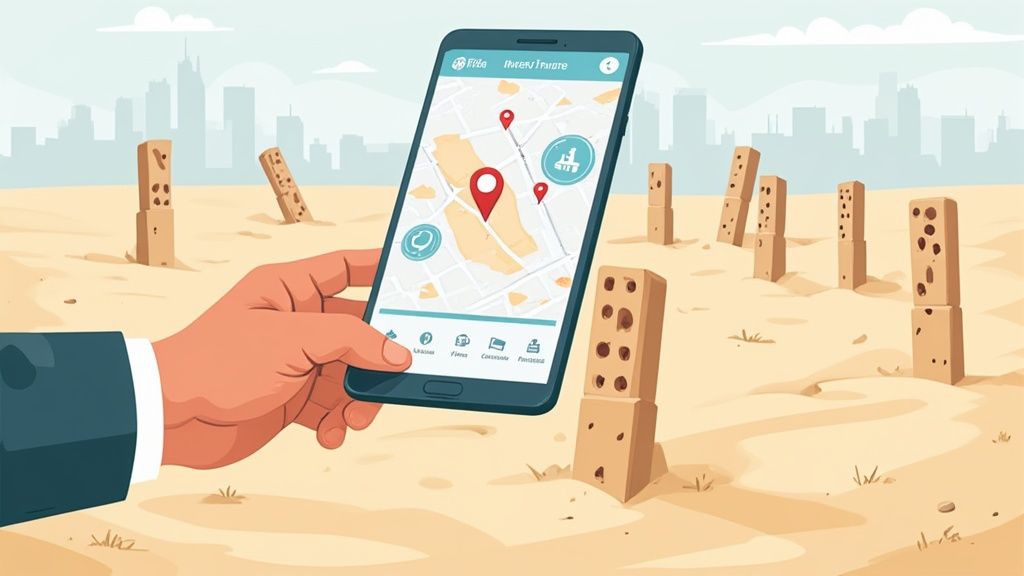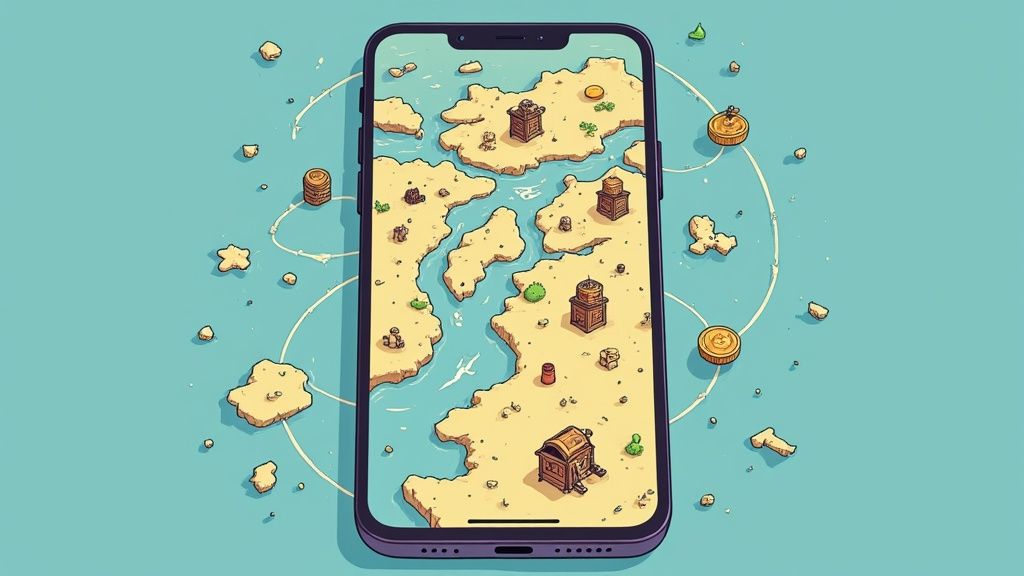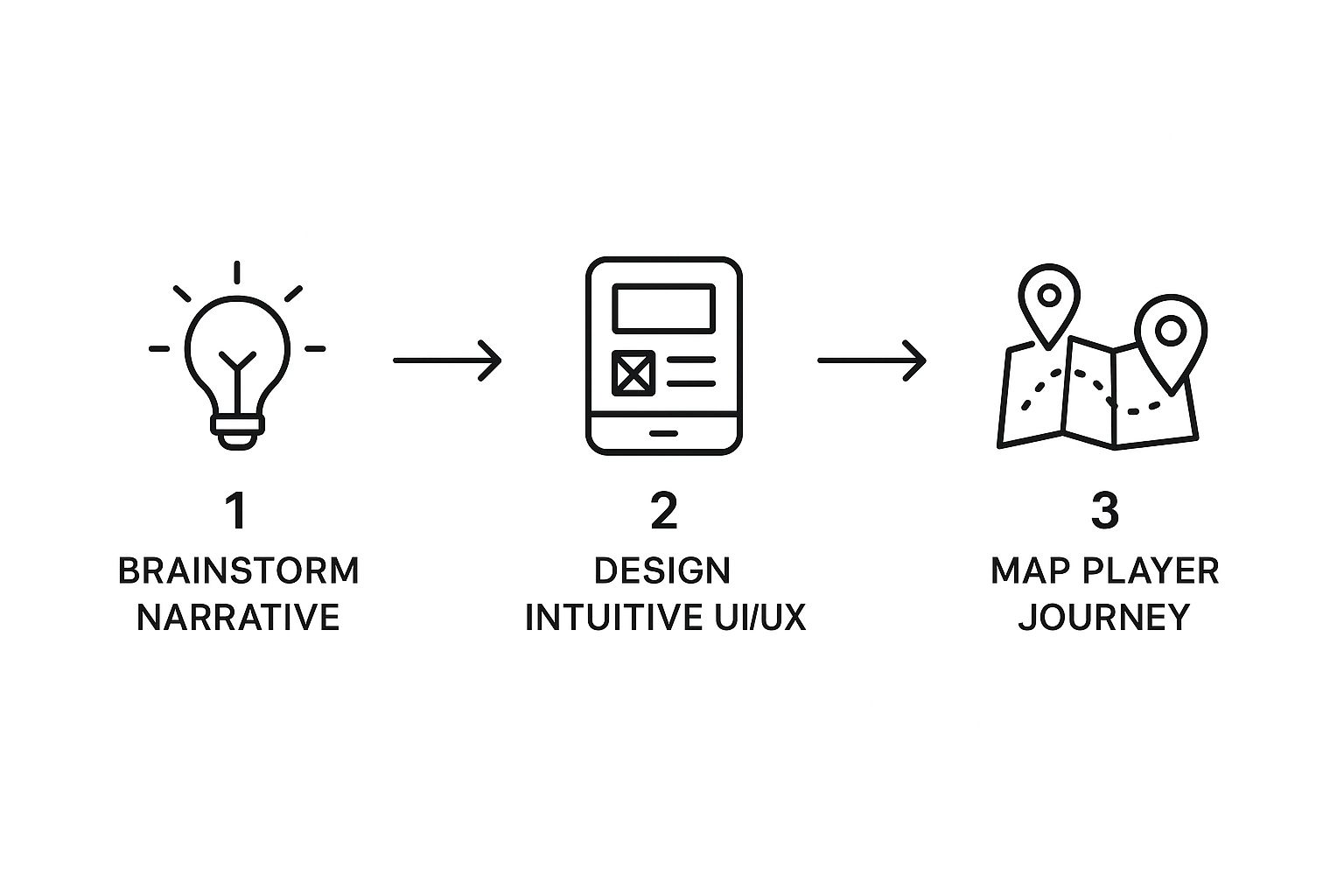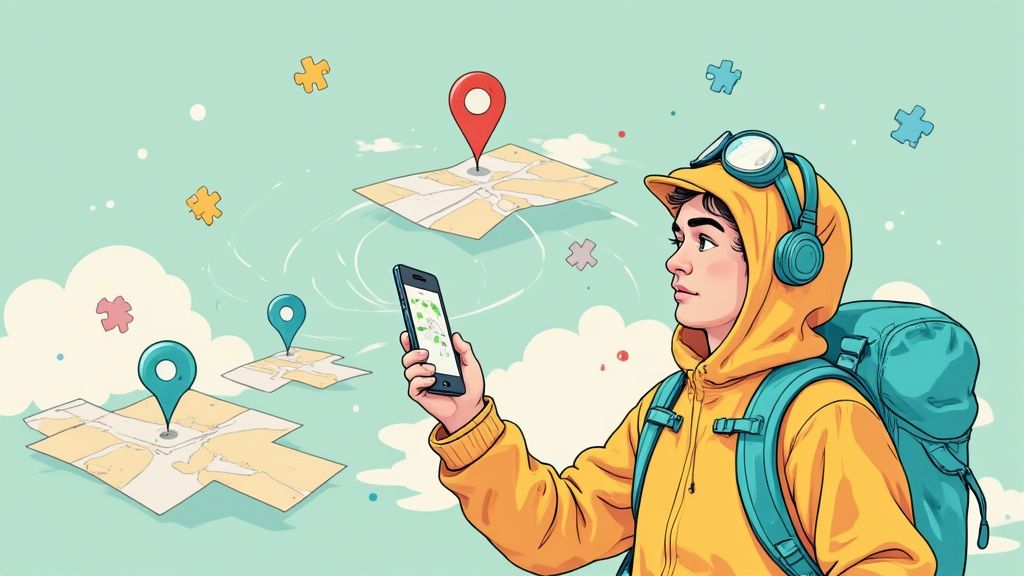Build Your Web3 Treasure Hunt App With Domino

A great treasure hunt app needs to nail that perfect mix of real-world discovery and digital interaction. It’s what creates an immersive experience that keeps people coming back. Now, imagine taking that a step further by weaving in Web3 elements like NFTs and crypto tokens. Suddenly, you’re offering real, verifiable rewards and turning a fun game into a genuinely valuable quest. This guide is all about showing you how to build exactly that with Domino.

Why Web3 Is Shaking Up Gamified Experiences
The classic scavenger hunt is getting a serious upgrade, and Web3 technology is at the heart of it. We're moving beyond simple points and digital badges. Now, players can earn actual on-chain assets that they provably own. This is more than just a passing trend; it’s a massive shift in how we approach user rewards and engagement.
The mobile app market is already a giant, and gamification has been a huge part of its growth. The industry is projected to hit a staggering $613 billion in revenue by 2025, and scavenger hunt apps have found a really popular spot within it. By blending city exploration with fun challenges, these apps have become powerful tools for building communities and engaging with brands.
What Makes a Web3 Treasure Hunt Different?
So, what really sets a Web3 treasure hunt apart from the classic version? It all comes down to the rewards and the technology behind them. Instead of just earning points in a database, players get something tangible.
Let’s break down the core components of your app and see how Web3 adds a new dimension with Domino.
Core Components of Your Treasure Hunt App
A quick look at the essential features and the Web3 twist you'll build with Domino.
| Feature | Traditional Approach | Web3 Approach with Domino |
|---|---|---|
| Player Profile | Standard user accounts (email/password). | Web3 Wallet Login. Users connect with their existing wallets for a secure, seamless entry point. |
| Interactive Map | GPS-enabled map showing clue locations. | Geofenced Smart Contracts. Clues are unlocked when a player's wallet enters a specific location. |
| Challenges & Puzzles | Text-based riddles or photo submission tasks. | On-Chain Verifications. Puzzles can require players to interact with a smart contract to prove completion. |
| Rewards System | In-game points, badges, or digital coupons. | NFTs & Crypto Tokens. Players earn verifiable digital assets they truly own, hold, and can trade. |
As you can see, the Web3 approach adds a layer of ownership and transparency that just wasn't possible before.
Here's a quick rundown of what makes this new model so powerful:
- Verifiable Ownership: When a player wins an NFT, it's theirs. They can hold it in their wallet, trade it, or sell it. This gives the reward real-world value that a simple in-game badge could never match.
- Decentralized Rules: The game's logic can be built into smart contracts on a blockchain. This makes the rules transparent and fair for everyone, which is a huge step in building trust with your users.
- Community Integration: Web3 is all about community. You can design your treasure hunt to reward actions that strengthen your community, like participating in a vote or holding a specific token. To get a better handle on this, check out our guide on how tokens in cryptocurrency fuel these ecosystems.
A well-designed Web3 treasure hunt does more than just entertain; it creates a micro-economy around your brand or community. Players aren't just consumers—they become stakeholders invested in the ecosystem's success.
From Idea to Launchpad
Taking your idea and turning it into a real, functioning app involves more than just writing code. You need a clear vision for the player's journey, a solid grasp of the game mechanics, and of course, the right tools to bring it all together.
For a great overview of the whole journey, it’s worth reading through the complete mobile app development process. Here, we’re going to zero in on the Web3 components and show you how Domino makes the technical side feel much less intimidating. We'll walk you through designing the experience, getting your environment set up, and launching a game that players will be excited to dive into.
Crafting Your App's Concept and Design
Every great treasure hunt starts with a story, not a line of code. Before you even think about the tech, you need to build the world your players will get lost in. What’s the big idea? Are they hunting for lost pirate gold, solving a high-tech corporate espionage case, or maybe uncovering a magical realm hidden just beneath the surface of their city?
This core theme is your anchor. It’s what makes the game feel like a real adventure. If you're going with a historical theme, your challenges might be trivia questions at local landmarks. For a cyberpunk hunt, maybe players are scanning QR codes hidden in plain sight and cracking digital codes. The trick is to make every clue, every location, and every reward feel like it belongs in that world.
Defining Your Player's Journey
Once you’ve got the story straight, it's time to think about how people will actually play the game. This is all about the user experience (UX) and user interface (UI). You could have the most amazing story ever, but if the app is a confusing mess, people will just give up. The whole experience should feel smooth and natural, pulling players from one clue to the next without a hitch.
Think about the entire flow from their perspective:
- Getting Started: How do they jump in? A simple Web3 wallet connection is usually the path of least resistance. Keep the sign-up process quick so they can get right to the fun.
- The Main Game: How do they get clues, submit their answers, and track how they're doing? This is your core gameplay loop, and it needs to be addictive.
- The Big Payoff: What happens when they finally solve the last puzzle? That final moment needs to feel like a real victory.
A great treasure hunt app doesn't feel like an app at all. It feels like a real-life adventure. Your design should fade into the background, letting the story and the thrill of discovery shine.
Designing Engaging Clues and Challenges
Alright, let's get to the good stuff: the hunt itself. To keep players hooked, you need challenges that are fun, clever, and, most importantly, doable. Just throwing a bunch of text-based riddles at them will get old fast.
Shake things up! Mix and match different types of challenges to keep the game exciting:
- Location Check-ins: Use the phone's GPS to confirm a player has physically arrived at a specific spot.
- Photo Missions: Make them snap a picture of a particular statue or unique piece of street art. You can even use Domino’s AI to help automatically verify the photos, which is a huge time-saver.
- Interactive Puzzles: Build in little digital minigames or quizzes that unlock the next clue.
- QR Code Scans: Plant QR codes out in the wild for players to find and scan.
As you're putting the visuals together, it never hurts to brush up on some app design best practices to make sure everything looks clean and is easy to navigate.
Ultimately, you want to build an experience that gets people to look at their surroundings in a whole new way. By nailing down your concept, mapping out the player's journey, and creating a fun mix of challenges, you're laying the groundwork for a Web3 treasure hunt people will be talking about long after they’ve found the prize.
Setting Up Your Domino Development Environment
Alright, you've got your killer concept mapped out. Now it's time to roll up your sleeves and bring this thing to life. This is where Domino steps in to be your command center for the entire project. The platform is built to handle the tricky blockchain stuff, so you can pour your energy into what really matters: making a fun, engaging experience for your players.
Getting started is surprisingly painless. First, you'll create your account on Domino and fire up a new project. This whole process is quick and lands you on a personal dashboard where the magic happens. I like to think of this dashboard as my mission control—it gives you a bird's-eye view of your quests, player analytics, and all your reward configurations.

The Domino dashboard gives you a clean, intuitive interface for managing every single part of your app.
Connecting Your Wallet and First Contract
One of the first things you'll be prompted to do is connect your crypto wallet, whether it's MetaMask, Coinbase Wallet, or another one you prefer. This is a non-negotiable step for any Web3 project. It’s your secure key to interacting with the blockchain—how you’ll deploy smart contracts and manage those sweet NFT rewards. Domino makes this super simple, guiding you through a secure connection right from the dashboard.
Next up is configuring your first smart contract. If that phrase makes you nervous, don't sweat it. Domino has templates that make it accessible, even if you’ve never touched a line of Solidity in your life. This first contract will act as the rulebook for your treasure hunt.
Here’s a breakdown of what you’ll be setting up:
- Game Logic: This is where you define the core rules. How many clues are there? What does a player need to do to officially win?
- Reward Parameters: You'll specify what the prize is. Is it an awesome NFT from a specific collection? A pile of your own custom tokens? You define it here.
- Player Tracking: This sets up how the contract will log each player's progress as they move through the hunt.
The real beauty of using Domino is that you're not stuck writing complex smart contracts from scratch. You're basically using a visual interface to piece together pre-built, audited contract components. This slashes development time and dramatically cuts down the risk of costly errors.
This approach gets you a solid foundation without the headache. As your game gets more popular, you can always layer in more complex features, but this initial setup is everything you need to get a working version out the door.
Building Your Basic App Architecture
With your wallet hooked up and your first contract ready to go, the next move is to structure the app itself. Domino offers a really flexible framework that plays nicely with different frontends. For a little inspiration, you can check out some of the apps and quests already built on Domino to see what other creators are doing.
Your initial architecture is all about setting up the core pieces that make the game tick. This means creating your quests (the clues), defining the tasks players must complete (like submitting a photo or checking in at a location), and then linking all of that back to your smart contract.
Getting this foundation right ensures that when a player completes a challenge in your app, the smart contract can automatically verify it and update their progress on-chain. It’s a seamless link between the player's actions and the blockchain's ledger.
Bringing Your Clues and Challenges to Life

Alright, this is the fun part. We're moving past the big-picture ideas and getting our hands dirty building the core gameplay. This is where your treasure hunt stops being a concept and starts feeling like a real, playable game. We'll focus on the heart of the experience: the clues, the challenges, and the mechanics that pull players through the adventure.
The soul of any treasure hunt is the journey, not just the destination. With Domino, you can weave this journey through the real world by connecting your app to GPS and mapping tools. This lets you design clues that only pop up when a player physically shows up at a specific set of coordinates, blending the digital and physical worlds perfectly.
Let Domino Handle the Game State
As people solve puzzles and race between locations, your app has to keep track of everything. Who solved what? Where are they headed next? This is what we call managing the "state" of the game, and Domino takes this entire headache off your plate.
Imagine a player cracks a tough riddle. Behind the scenes, Domino can be set up to automatically:
- Check that clue off as complete for that user.
- Log their progress in the overall quest.
- Reveal the next clue in the sequence.
You don't need to be a backend wizard to set this up. It's all done through Domino's visual interface, where you build the logical flow of your hunt. If you want to see a live example of how this works, check out the Domino Quests app. It's a great blueprint for structuring these multi-step adventures.
This is where the magic really happens. You're linking something that happens in the real world (a player arriving at a statue) to an on-chain event (updating a smart contract). This creates a secure, verifiable record of everyone's progress.
Crafting Challenges That Don't Get Stale
Let's be honest, a hunt that's just a series of "go here, then go there" instructions is boring. The challenges are what make the game memorable and fun. You need to mix things up to keep players engaged.
Think about a good blend of challenge types. Domino is flexible enough to handle everything from simple social media tasks to sophisticated AI-powered verifications. You could ask players to snap a photo of a specific landmark and use AI to confirm it’s the right one, or make them solve a puzzle that reveals a password for the next location.
The use of AI in these kinds of experiences is exploding. By 2025, it’s expected that nearly two billion people will be using AI tools, many on a daily basis. We’re already seeing this in modern scavenger hunt apps that use AI to create smarter, more interactive challenges.
With Domino, you have the tools to build out a rich variety of tasks that will keep your players hooked and excited for whatever you throw at them next.
Making the Treasure Worth the Hunt with Web3 Rewards

Let's be honest, a treasure hunt without an actual treasure is just a long walk with puzzles. In the Web3 world, this is your chance to offer players something with real, provable value. We're talking about moving past simple digital badges and giving winners true ownership of their prize.
Using a platform like Domino, you can easily mint NFTs, hand out custom tokens, or dream up other on-chain rewards. This completely flips the script on player motivation. Suddenly, they aren't just playing for bragging rights; they're competing for a unique asset that's truly theirs. Think exclusive digital art, a special access pass for your community, or even a cut of a crypto prize pool. This is where a Web3 treasure hunt app really shines.
What Kind of Treasure Will They Find?
Picking the right prize is crucial for building real excitement. Your reward needs to feel like it fits the theme and effort level of your hunt. You’ve got a few fantastic options here, and each one brings something different to the table.
Here are a few popular models you can set up right inside Domino:
- Exclusive NFTs: Mint a limited-edition NFT collection just for your hunt winners. Scarcity is a powerful motivator, and this turns the prize into a genuine collectible.
- Custom Tokens: Give players your project's native token as they hit milestones or win the grand prize. This is an awesome way to get your token into the hands of your most dedicated community members.
- Physical Item Redemption: Bridge the gap between digital and physical. The NFT your winner receives could act as a "claim ticket" for a real-world item, like exclusive merch.
Don't underestimate the power of a well-designed treasure hunt app. These gamified experiences mix physical and digital interaction in a way most marketing campaigns can only dream of. In fact, mobile app conversion rates are often 100% to 300% higher than mobile websites. It’s a huge opportunity for brands to connect with people in a meaningful way. You can dig into more stats on mobile app engagement rates if you're curious.
The Final Pre-Launch Sanity Check
Okay, before you hit the big red "launch" button, it's time for one last, thorough check. This is your final chance to smooth out the rough edges and make sure everything is ready for showtime.
A soft launch or a beta test is your secret weapon here. Get a small, trusted group of people to run through the entire experience from start to finish. Their feedback is gold for catching bugs and improving the game before it goes public.
Here’s a quick-and-dirty checklist to run through:
- Beta Test Ruthlessly: Make sure your testers poke and prod everything. Every clue, every challenge, and especially the reward claim process.
- Get Honest Feedback: Ask them straight up: What was fun? What was frustrating? Was that one clue in the park totally impossible to solve?
- Polish the App: Use that feedback to kill bugs, tweak clue difficulty, and generally make the user experience feel seamless.
- Prep Your Launch Hype: How are you going to announce this? Get your social media posts, blog articles, and email blasts ready to go.
- Have a Community Plan: Be ready to jump in and answer questions once the hunt is live. A little active engagement with your players goes a long, long way.
Got Questions About Your Web3 Treasure Hunt? Let's Clear Things Up.
Jumping into your first Web3 project can feel a little daunting, I get it. You're probably wondering about the nitty-gritty details. Let's walk through some of the questions I hear most often from people building their first treasure hunt.
"Do I Need to Be a Blockchain Guru to Use Domino?"
Honestly? No, not at all. That’s the whole point of a platform like Domino. It does the heavy lifting on the blockchain side of things for you.
You don't need to be a Solidity developer or a blockchain protocol expert. As long as you understand the basics—what a crypto wallet is, what an NFT is—you're good to go. Domino handles the backend mechanics, letting you pour your energy into what really matters: creating a killer game experience.
"What's This Actually Going to Cost Me?"
This is a big one. Your costs will generally fall into three buckets.
First, you've got your platform fee for using Domino itself. Then, there are the blockchain transaction fees, often called “gas fees,” which you’ll pay for things like minting the NFT rewards for your players. These fees can vary a lot depending on the network you use; Polygon, for instance, is usually a much more budget-friendly option than Ethereum.
Finally, you might have some costs for any extra tools you decide to use, like a premium mapping service. My advice? Map out a clear budget from the start so you know exactly what you're working with.
A classic rookie mistake is forgetting to account for gas fees, especially when the network is busy. Always build a buffer into your budget for transaction costs. This will save you—and your players—from nasty surprises when it's time to distribute those awesome rewards.
"How Do I Keep Players Hooked?"
It all comes down to a great story and creative challenges. A strong, immersive theme is your foundation.
Once you have that, you can build on it:
- Switch Up the Puzzles: Don't make every step a simple "go here, scan this." Mix it up! Think riddles, photo-based tasks, or even AR filters to make things dynamic and unpredictable.
- Create a Difficulty Curve: You want to ease players in. Start with a few simpler clues to build momentum and confidence. Then, you can gradually ramp up the difficulty to make that final prize feel truly earned.
- Make the Rewards Count: A custom-designed NFT that ties into your game's theme is infinitely more exciting than a generic prize. That unique digital collectible gives players serious bragging rights and a real incentive to finish the hunt.
Ready to build an experience your community will be talking about for months? With Domino, you can get a Web3 treasure hunt off the ground in a matter of minutes.
Level Up Your dApps
Start using Domino in minutes. Use automations created by the others or build your own.
